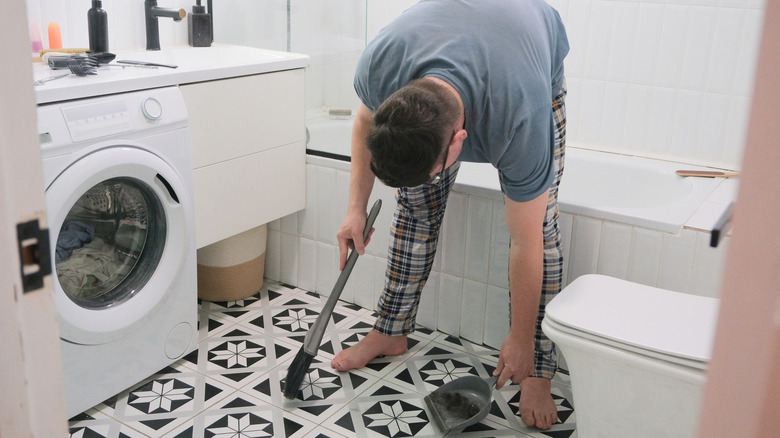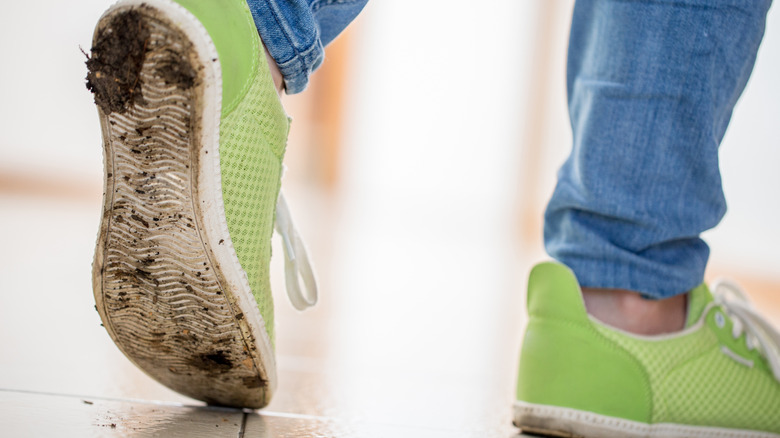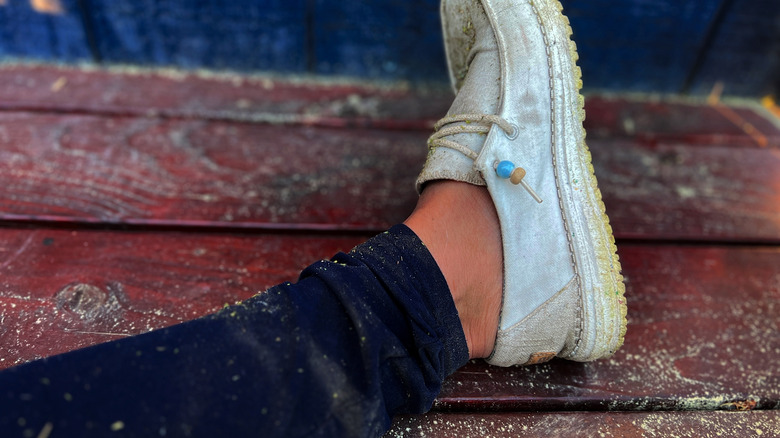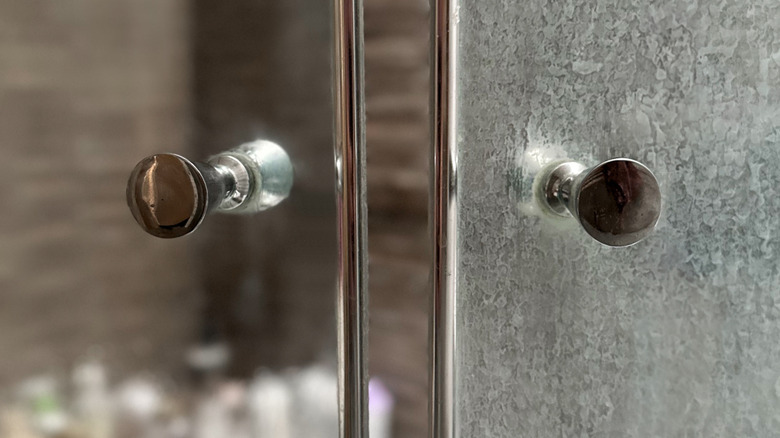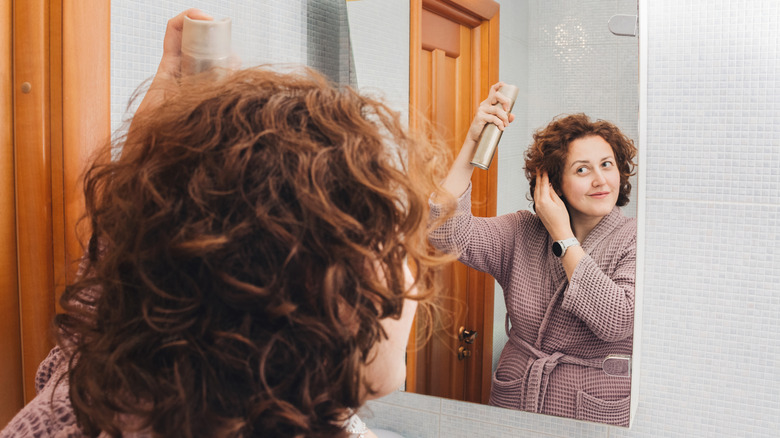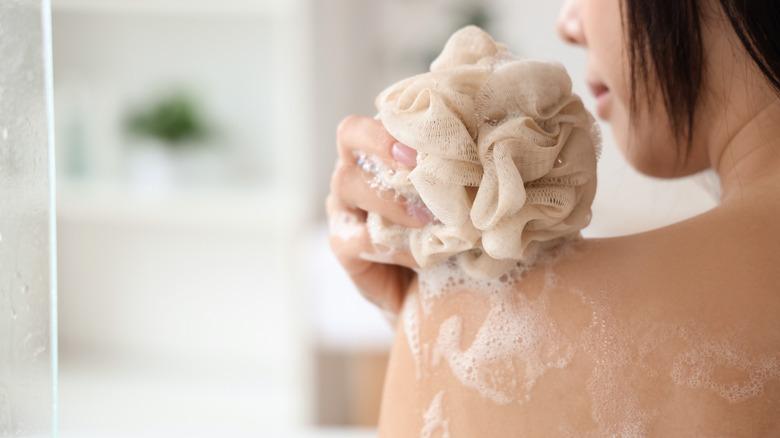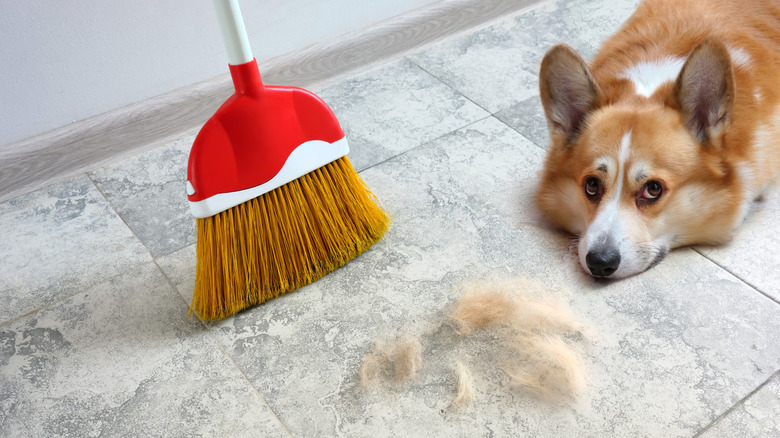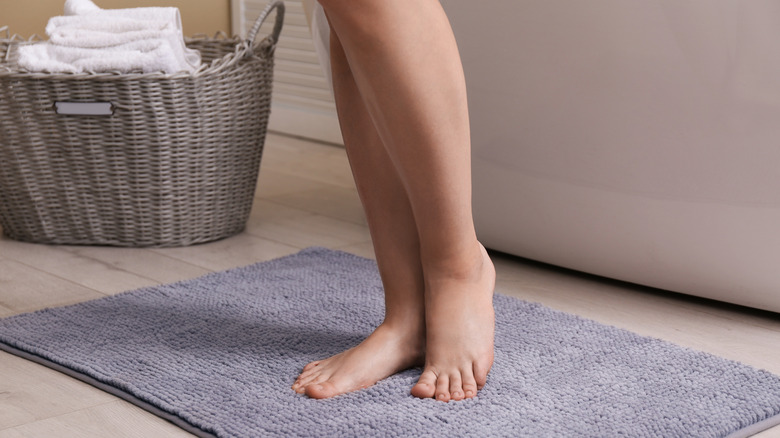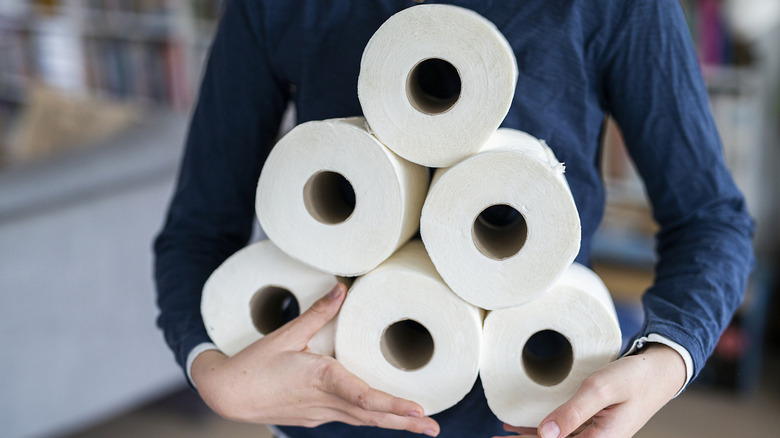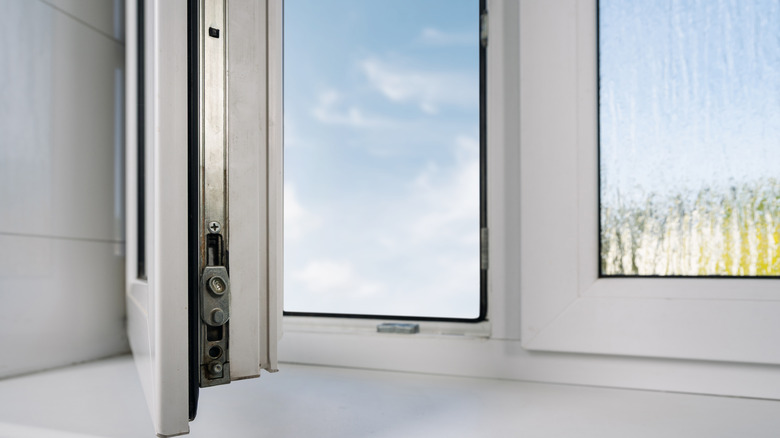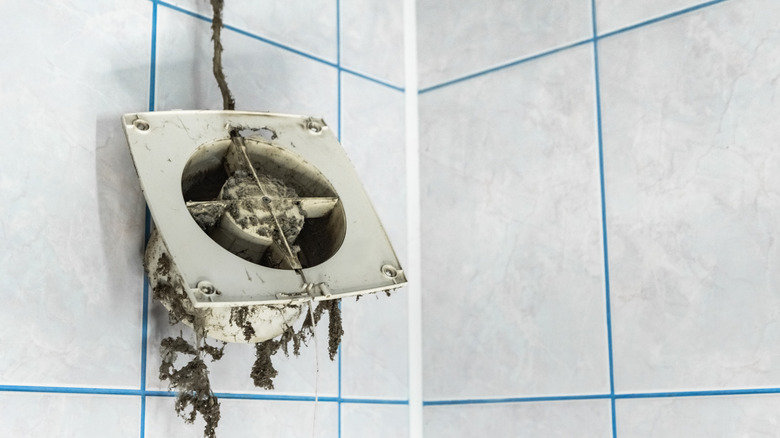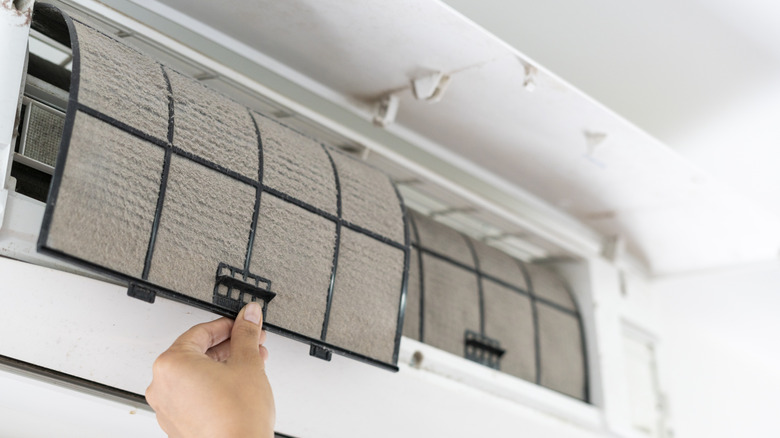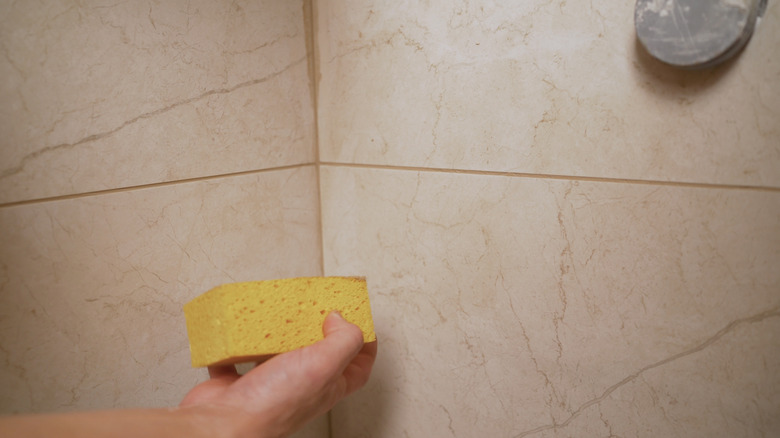Why Is My Bathroom So Dusty? 12 Reasons For The Buildup
Dust is arguably one of the most frustrating aspects of trying to keep your home clean. Sometimes it can seem like even if the surfaces around your home were just wiped down, you still see specks of dust the next day. Dust itself isn't a single entity, but rather a combination of multiple substances, including dirt, pollen, dead skin cells, and even certain personal care products.
Not only does dust tend to accumulate behind and underneath furniture, but it may even show up in seemingly odd places from time to time. This includes your bathroom. It's not just your bathroom floors that fall victim to those notorious dust bunnies, though. You might see unexplained dust around your shower, tub, vanity, walls, and more. Getting dust under control can help improve cleanliness and overall health, as these particles are also known to aggravate allergies and respiratory diseases. Aside from regularly dusting and cleaning your bathroom, you can also decrease dust accumulation by addressing some of its most common causes.
Dirt from shoes can settle into dust
Dirt and soil are common components of outdoor dust that can make their way into your home. While sometimes the wind blows in various debris when you have the windows open, your shoes are the more likely culprit behind this problem. Wearing outdoor shoes in your home can lead to dirty floors, but these particles can break down into dust, too. If you wear outdoor shoes while in your bathroom, this could be a contributing factor.
To that end, one of the best ways you can minimize dirt accumulation is to not wear outdoor shoes around your home. You especially should not wear them in your bathroom, as this can make floors dirty and eventually lead to dust buildup. Consider leaving outdoor shoes by your front door, and asking any guests to do the same. If you insist on wearing shoes indoors, consider having a pair that are for inside use only (or a pair of slippers), so you aren't tempted to wear dirty shoes around your house.
Pollen from hair and clothing can end up as dust in your bathroom
During the spring and autumn months, pollen can be a challenging enemy to contend with. You've likely heard the advice of showering immediately after coming indoors to help prevent spreading pollen throughout your home. Even if you follow this important rule of thumb, though, you could still be inadvertently creating dust problems in your bathroom. As you head to your shower, the pollen on your body inevitably follows you. Some of this gets rinsed off in the shower, but some could also get left behind along your bathroom surfaces. Here, pollen can eventually break down into dust.
Dealing with pollen can be tricky, but it's not impossible to keep these materials at bay. Help reduce this problem by wiping off your hair and clothing with a dry towel before you come inside your home to take a shower, similar to what you should do with removing pollen from pets. Taking off outwear before you come into the house can help, too. While it's difficult to 100% prevent pollen from getting inside your house, these steps can help. Not only will your allergies thank you, but you may experience fewer dust problems, too. Taking care of indoor pollen can allow you to deal with other issues, such as how to get rid of the pollen coating your home.
Soap scum accumulation may trap dust particles along bathroom surfaces
Soap scum is a certainly an unwelcome phenomenon that happens to be a common problem in bathrooms. This white residue isn't actually scum at all, but is the result of hard water minerals that combine with soap, dead skin cells, and other debris. While not a direct contributor to dust, caked-on soap scum can effectively trap dust particles and create a larger mess.
To address this issue, you need to do what you can to help reduce soap scum around any sinks, tubs, and showers. Rinsing and drying sinks and tubs after every use can help remove some of the debris that combines with hard water minerals to form soap scum. You may even be able to fight stubborn soap scum with certain ingredients you likely have at home. Thoroughly cleaning bathroom surfaces on a weekly basis is another good way to reduce overall soap scum problems in your bathroom. If you do have hard water, consider investing in a water softener to help prevent soap scum from forming in the first place. Once you get soap scum under control, you may have fewer problems with dust particles sticking to these surfaces.
Hairspray residue is a common source of bathroom dust
If you're a hairspray user, you might be accustomed to having to deal with sticky residue around your bathroom surfaces from time to time. Surprisingly, it's this same buildup that could also contribute to your bathroom dust problems. Like soap scum, residue from certain personal care products leave behind sticky film. Over time, dirt, dead skin cells, and other particles might attach to this residue and accumulate more dust. Another possibility is that hairspray particles can flake off from your skin and eventually transform into household dust.
While you don't necessarily have to give up your favorite hairspray, it's good idea to pay more attention to its aftermath if you're dealing with persistent dust problems. This especially includes your vanity, floors, and walls. Cleaning up this residue on a regular basis can help minimize dust from accumulating. You can even quickly run a moist cloth along affected surfaces after using your hairspray. Once the hairspray dries, though, it's time to use some warm water and dish soap to help break down these types of oil-based messes. You may even need a commercial cleaning agent, along with some scrubbing power, to take care of more caked-on residues.
Dead skin cells can contribute to dust formation
Humans naturally shed dead skin cells on a regular basis, and bathing or rubbing helps to accelerate this process. Intentional exfoliation is yet another way dead skill cells shed even quicker. All of this shedding occurs at the epidermal (outer) layer of your skin, with new cells replacing dead ones every four weeks, on average. Unfortunately, dead skin cells also contribute to dust accumulation. Since your bathroom is the epicenter of bathing and personal care, it's easy to see how dead skin cells shed in this area more easily.
While you obviously can't prevent dead skin cell shedding, you can help minimize related dust problems. Cleaning all bathroom surfaces at least once a week is an important first step to get rid of dead skin cells and other debris lurking around the space. You might also need to clean your shower or bathtub more often to remove dead skin cells. This will be especially helpful if you use a loofah or other exfoliator when you bathe.
Human hair and pet fur may eventually turn into dust
While it might seem weird to think about, hair from humans and pets can also contribute to household dust. This occurs as the particles break down over time and mix with other debris and dust. Hair is also notorious for sticking to surfaces, which doesn't help matters any. You may have even noticed that hair and pet fur is often mixed together with dust when you sweep your bathroom floors.
It can be challenging to reduce hair particles in your bathroom, but it's not impossible. One step is to try and keep your fur babies out of the room as much as possible. You can minimize the amount of hair your dogs and cats shed by brushing them on a regular basis. Another method is to consider other ways to get rid of pet hair in your home to prevent it from making its way into your bathroom. Finally, make it a point to pick up any hair from the floor, tub, and around the sink on daily to help keep this hairy dust contributor in check.
Lint from towels and bathmats contribute to dust
Bath towels, washcloths, and bathmats are all bathing necessities, but these can also leave lint behind that contributes to dust. This is especially problematic with new towels, where it can seem like lint gets everywhere until the fabric has been broken in with a few washes. Linty towels and accessories might not seem like a big deal, but these tiny fibers can mix in with other debris sources to create dusty issues.
Cleaning up any lint that you notice is an important first step to control this problem. Aside from going on lint patrol around your bathroom, you can also help address the lint situation by prepping new towels. Try washing these pieces with 1 cup of white vinegar in your laundry machine, or you can pre-soak them in a baking soda and water mixture to help reduce shedding. If using either product, you will need to wash the towels again per usual. Ideally, you should take these steps before the towels ever make it into your bathroom to help keep lint at a minimum. It's also worth checking all care labels on bath towels and mats to prevent fuzz balls from forming on your towels that could later turn into lint.
Toilet paper and facial tissue can also create a linty mess
Clothing and towels aren't the only sources of lint, especially in your bathroom. Excessive lint around your floors, walls, and other spots in the room may point to toilet paper and facial tissue lint. Both types of products can create lint that contribute to bathroom dust. If you look closely, you might even see lint residue around the spots you normally keep these paper products. In the long-run, this fine powdery lint builds up and creates dusty problems around your bathroom.
While getting rid of paper products in your bathroom likely isn't an option, there are still ways to minimize the linty messes that toilet paper and tissues can create. The first method is to dry dust around the vicinities you keep these types of products on a regular basis. This will help to keep some of this paper-based lint in check. You can also help minimize this problem by choosing stronger/thicker paper product versions, as well as brands that are labeled as "lint-free."
Too much humidity and moisture can lead to more dust mites
In many cases, dust and dust mites go hand in hand. The presence of dust can lure these microscopic bugs, who feed on the dead skin cells and other materials in the debris. Dust mites also further contribute to dust accumulation, thanks to their waste products and the exoskeletons they leave behind when they die. Aside from dust itself, dust mites generally prefer to hang out on fabric-based surfaces, such as bedding, clothes, upholstered furniture, and carpeting. However, they will go in any area of your home where dead skin cells are plentiful. Aside from cleaning up dust, you can also reduce the humidity and moisture dust mites thrive on and need to reproduce. Over time, fewer dust mite problems can mean less dust and end this aggravating cycle.
The key to reducing humidity in your bathroom is increased ventilation. This can involve opening a window after showering, if available, or even keeping the bathroom door cracked open to allow the warm humid air to escape. You can also use a dehumidifier to decrease overall humidity levels in your bathroom, and subsequently reduce dust mite problems. Since dust mites need relative humidity levels between 55% and 75% to survive, you should keep your home's level below 50%. Doing so can help to keep dust mites out of your bedroom, too. While controlling dust mites helps reduce overall dust, it has the added benefit of improving quality of life for people who have dust mite allergies and asthma, too.
Dust can build up on bathroom exhaust fans
The benefits of a bathroom exhaust fan are abundant, as this device is a great way to remove moisture and odors from the air. Due to the upward motion of these devices, though, exhaust fans can also inevitably pull dust. Over time, you might notice some undesirable dusty buildup on the fan itself. This makes the exhaust fan less effective, too. Not only can this lead to an unhealthy situation, but a dusty exhaust fan also becomes a fire hazard.
Consider checking out the exhaust fan every time you clean your bathroom. Catching any dust accumulation around the system allows it to work better, all while improving the dust situation in this space. First, turn off the power, and then remove the protective panel to assess how much dust there is. In some cases, a simple wipe down of the exterior with a damp cloth will do. Especially dusty situations call for removal and cleaning of the entire fan itself, though. For best results, you should clean the exhaust fan at least every 3 to 6 months, or any time you notice dust buildup.
Dirty HVAC filters can lead to dust buildup in your bathroom
Having an AC supply vent in your bathroom can help keep the space comfortable, while regulating temperature and humidity. However, this source of comfort and humidity regulation could possibly be an unintentional source of dust as well. A working HVAC system is responsible for not only providing air, but it also helps to draw dust and other particles through its return vents. But, when the air filters are dirty, the system can no longer pull dust as it should, which can lead to more debris in the supply and return vents. Dust may then gradually accumulate throughout your bathroom, because it simply has nowhere else to go. You might even notice reduced airflow from your HVAC system when the filters are dirty.
If you're seeing more dust in your bathroom than normal, without any obvious cause, it may be time to check out the air filters in your HVAC system. It's also worth keeping reminders for changing your air filters on a regular basis. How often you should change your air conditioner filter can vary based on how dusty your home gets, the types of filters you buy, and the HVAC system itself. As a general rule of thumb, replace the filters at least every other month, or as soon as they're dirty.
Dust can be a source of buildup in your shower grout
Grout is an important feature to have in terms of aesthetics and overall shower function, but these indented spaces are also notorious for accumulating debris. Part of this has to do with the porous nature of grout, which can also break down and crack over time. While you might be rightfully concerned about mold and mildew buildup in these tiny lines, it's important to consider other types of debris. This can include dust. Unfortunately, simply wiping down shower tiles doesn't address dust buildup on grout lines, and the debris can continue to accumulate.
To get a handle on dusty shower grout, you will need to clean these small spaces on a regular basis. This will inevitably involve scrubbing the grout directly to remove dust and other debris, rather than just wiping the area with a cloth. Alkaline cleaners are considered effective options for shower grout because they help breakdown dirt and grease. One example is baking soda, which has the added bonus of being able to scrub stains without being too abrasive. You can mix baking soda with a small amount of water to scrub your grout clean, and then rinse away with clean water. Another option is to combine ¾ cup baking soda with 1 tablespoon dish soap and ¼ cup of hydrogen peroxide for a stronger fizzing DIY cleaner. Purely acidic products do not work well for grout, because these can break down the materials and increase the risk of cracks.
